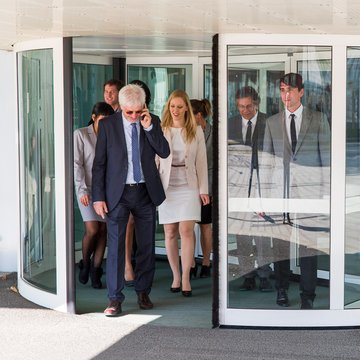Open Sesame!
Have you ever walked up to or even into a closed glass door? Or have you ever been caught in a sliding door? Often these types of collisions have a mild outcome and you can look back on such situations and laugh, but sometimes these types of collisions can cause considerable damage: that is why many doors in public institutions are now controlled automatically; sensors are responsible for the safety of these doors and their “intelligence” is increasing.
Automatic Sliding Doors
Beyond Borders
Almost all supermarkets today are equipped with sliding doors that open automatically, and even the commuter rail (S-Bahn) doors close almost by themselves. We will enter sensor-controlled door systems almost every day, but have you ever thought about how they actually work?
One-way Light Barriers
Beyond Borders
A simple safety system is the one-way light barrier, which recognizes barriers at the installed height: A light source emits a permanent beam that is received by a detector on the opposite side. This is controlled via electronics. The receiver sends an alarm if it does not detect the light sent by the light source with the feedback: barrier.In sliding door systems, the light sources are used with infrared radiation that is invisible to the human eye. Usually, the sensors are installed at the height of a person’s ankles.
If the connection between the emitter and the receiver is interrupted, then the door’s closing mechanism is suspended for a set time interval. In ground-level doors this safety mechanism is sufficient. Light barriers are still commonly combined with additional safety mechanisms, for example if it is necessary to step up or down a step when entering a door, making it necessary to protect an arm on a railing from getting caught: the technology ranges from pressure sensors to the installation of further light barriers at different heights.
Light Curtains
Beyond Borders
Simple light barriers are being replaced more and more often by so-called light curtains. In this technology, many emitter and receiver units form a fine line grid to prevent people or objects from getting caught in a sliding door. Light curtains are also very widespread in industrial applications in which access points must be monitored.
Complex Sensor Technology for Revolving Doors
Beyond Borders

Revolving doors prevent a draft and save – compared to sliding doors – energy costs. They are, therefore, preferably used in large buildings. The safety requirements are physically trivial for sliding doors and extremely complex for revolving doors. Most safety equipment has to be tested to meet DIN18650 requirements.
We will introduce two standard optoelectronic methods that provide protection via distance measurements: inexpensive triangulation methods and complex laser scanners that use time-of-flight measurements.
Meet our Experts
Beyond Borders

Further Information
Beyond Borders




